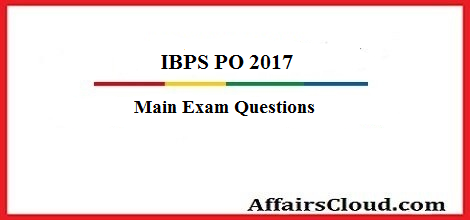Hello Aspirants.
Welcome to Online Reasoning Section with the explanation in AffairsCloud.com. Here we are creating Best question samples for IBPS PO 2017. We have included Some questions that are repeatedly asked in bank exams !!!
Click Here to View Cumulus Course: IBPS PO 2017
IBPS PO 2017: Reasoning Test– 6 PM Every Day
IBPS PO 2017: Quants Test– 7 PM Every Day
Q(1-5). Each question contains Quantity I and Quantity II. Find relationship between both the quantities.
- Quantity I: Cost of flooring, if a Circle having diameter of 378m with cost of flooring for one sq m is Rs.2
Quantity II: Cost of flooring, if a square having diagonal of 474m with cost of flooring for one sq m is Rs.2
A. Quantity I > Quantity II
B. Quantity I < Quantity II
C. Quantity I ≥ Quantity II
D. Quantity I ≤ Quantity II
E. Quantity I = Quantity II or relationship cannot be establishedB. Quantity I < Quantity II
Solution:
Quantity I : 22/7*189*189*2 = 224532
Quantity II : 474*474 = 224676 - Quantity I: Age of Son, if Mother’s age will be same as Father’s present age after 6 years. Son’s age is half of Mother’s present age. Father’s Present age is 42.
Quantity II: Age of Son, if Fathers age is 42 Mother’s age is 30 and Son’s is age ¼ of sum of Father and Mother’s age
A. Quantity I > Quantity II
B. Quantity I < Quantity II
C. Quantity I ≥ Quantity II
D. Quantity I ≤ Quantity II
E. Quantity I = Quantity II or relationship cannot be establishedE. Quantity I = Quantity II or relationship cannot be established
Solution:
Quantity I: Mother age = 42-6 = 36 Son = 18
Quantity II : 42+30/4 = 18 - Quantity I: Interest after 2 years, if Rs.2500 is compounded annually at the rate of 8%
Quantity II: Interest rate after 2 years, if Rs 3500 is compounded annually at the rate of 6%
A. Quantity I > Quantity II
B. Quantity I < Quantity II
C. Quantity I ≥ Quantity II
D. Quantity I ≤ Quantity II
E. Quantity I = Quantity II or relationship cannot be establishedB. Quantity I < Quantity II
Solution:
Quantity I: 2500(1+8/100) 2 – 2500 = 416
Quantity II: 3500(1+6/100) 2 – 3500 = 432.6 - Quantity I: Speed in Still Water, if Speed of Downstream is 36Km/hr and Speed of Upstream is 24Km/hr
Quantity II: Speed in Still Water, if boat covers distance of 36Km Down Stream in 1 hour and rate of current is 7 Km/hr
A. Quantity I > Quantity II
B. Quantity I < Quantity II
C. Quantity I ≥ Quantity II
D. Quantity I ≤ Quantity II
E. Quantity I = Quantity II or relationship cannot be establishedA. Quantity I > Quantity II
Solution:
Quantity I: 30 Km/hr.
Quantity II: 29 Km/hr - Quantity I: Profit of Ramu, if Ramu invested Rs 5000 and Ravi invested Rs. 4000 at the start of business after 6 Months Ramu withdraws Rs.1000 from his investment.What is the total profit made by X at the end of the year?
Quantity II: Profit of Ramu, if Ramu invested Rs 4000 and Ravi invested Rs.5000 at the start of business after 6 Months Ramu added Rs.1000 to his investment. What is the total profit made by X at the end of the year?
A. Quantity I > Quantity II
B. Quantity I < Quantity II
C. Quantity I ≥ Quantity II
D. Quantity I ≤ Quantity II
E. Quantity I = Quantity II or relationship cannot be establishedA. Quantity I > Quantity II
Solution:
Quantity I: Ramu = 9/17*X
Quantity II: Ramu = 9/19*X
Q(6-10) Study the given table and answer the following questions.

- What is the total no of Males and Females in all States together?
A. 2341198
B. 2351398
C. 2361398
D. 2251398
E. NoneB. 2351398
Solution:
220626+211246+263714+233072+274404+239792+200498+230220+230940+246886 = 2351398 - In which of the following state No of Adult Males is highest?
A. Nagaland
B. Sikkim
C. Tripura
D. Manipur
E. MeghalayaE. Meghalaya
Solution:
Nagaland: 220626*11/17 = 142758
Sikkim: 211246*5/7 = 150890
Tripura: 263714*7/11 = 167818
Manipur: 233072*5/8 = 145670
Meghalaya: 274404*8/13 = 168864 - No of Male Children in Nagaland is approximately what percent of the total population in Nagaland
A. 13%
B. 15%
C. 17%
D. 19%
E. NoneC. 17%
Solution:
Male Children: 77868
Total Population: 220626+239792 = 460418
% = 77868/460418 = 17% - What is the difference between total no of Female Children in Sikkim and Tripura together and total No of Adult Females in Manipur and Meghalaya together?
A. 185430
B. 185630
C. 185460
D. 186430
E. NoneA. 185430
Solution:
Female Children in Sikkim and Tripura: 200498*6/17 + 230220*4/15 = 132156
Adult Females in Manipur and Meghalaya : 230940*7/10+246886*12/19 = 161658+155928 = 317586
Difference = 185430 - Difference between Male children and female children is highest in which State?
A. Nagaland
B. Sikkim
C. Tripura
D. Manipur
E. MeghalayaC. Tripura
Solution:
Nagaland: 220626*6/17 – 239792*5/14 = -7772
Sikkim: 211246*2/7 – 200498*6/17 = -10408
Tripura: 263714*4/11 – 230220*4/15 = 34504
Manipur: 233072*3/8 – 230940*3/10 = 18120
Meghalaya: 274404*5/13 – 246886*7/19 =14442
AffairsCloud Recommends Oliveboard Mock Test
AffairsCloud Ebook - Support Us to Grow
Govt Jobs by Category
Bank Jobs Notification




